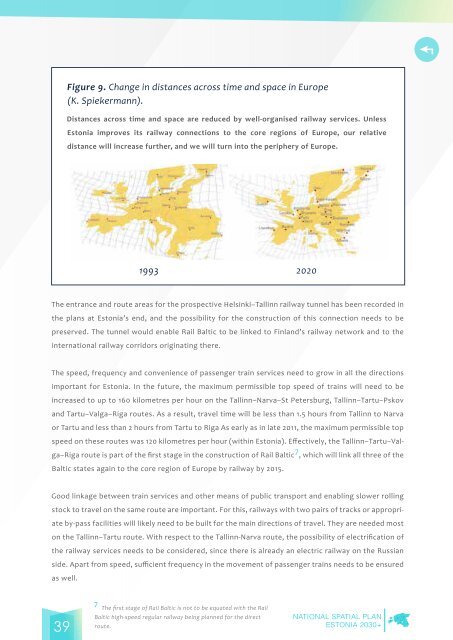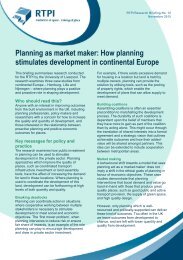estonia-2030_en
estonia-2030_en
estonia-2030_en
Create successful ePaper yourself
Turn your PDF publications into a flip-book with our unique Google optimized e-Paper software.
Figure 9. Change in distances across time and space in Europe(K. Spiekermann).Distances across time and space are reduced by well-organised railway services. UnlessEstonia improves its railway connections to the core regions of Europe, our relativedistance will increase further, and we will turn into the periphery of Europe.19932020The <strong>en</strong>trance and route areas for the prospective Helsinki–Tallinn railway tunnel has be<strong>en</strong> recorded inthe plans at Estonia’s <strong>en</strong>d, and the possibility for the construction of this connection needs to bepreserved. The tunnel would <strong>en</strong>able Rail Baltic to be linked to Finland’s railway network and to theinternational railway corridors originating there.The speed, frequ<strong>en</strong>cy and conv<strong>en</strong>i<strong>en</strong>ce of pass<strong>en</strong>ger train services need to grow in all the directionsimportant for Estonia. In the future, the maximum permissible top speed of trains will need to beincreased to up to 160 kilometres per hour on the Tallinn–Narva–St Petersburg, Tallinn–Tartu–Pskovand Tartu–Valga–Riga routes. As a result, travel time will be less than 1.5 hours from Tallinn to Narvaor Tartu and less than 2 hours from Tartu to Riga As early as in late 2011, the maximum permissible topspeed on these routes was 120 kilometres per hour (within Estonia). Effectively, the Tallinn–Tartu–Valga–Rigaroute is part of the first stage in the construction of Rail Baltic 7 , which will link all three of theBaltic states again to the core region of Europe by railway by 2015.Good linkage betwe<strong>en</strong> train services and other means of public transport and <strong>en</strong>abling slower rollingstock to travel on the same route are important. For this, railways with two pairs of tracks or appropriateby-pass facilities will likely need to be built for the main directions of travel. They are needed moston the Tallinn–Tartu route. With respect to the Tallinn-Narva route, the possibility of electrification ofthe railway services needs to be considered, since there is already an electric railway on the Russianside. Apart from speed, suffici<strong>en</strong>t frequ<strong>en</strong>cy in the movem<strong>en</strong>t of pass<strong>en</strong>ger trains needs to be <strong>en</strong>suredas well.7 The first stage of Rail Baltic is not to be equated with the Rail39Baltic high-speed regular railway being planned for the directroute.




